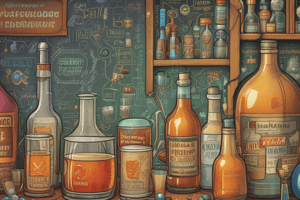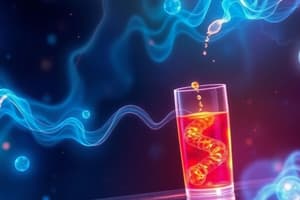Podcast
Questions and Answers
What percentage of alcohol is metabolized by gastric alcohol dehydrogenase in the liver?
What percentage of alcohol is metabolized by gastric alcohol dehydrogenase in the liver?
- 15% (correct)
- 20%
- 5%
- 10%
Women have more gastric alcohol dehydrogenase (GAD) than men.
Women have more gastric alcohol dehydrogenase (GAD) than men.
False (B)
What metabolite of alcohol is responsible for the discomfort felt after drinking?
What metabolite of alcohol is responsible for the discomfort felt after drinking?
Aldehyde
Alcohol is primarily metabolized by _______ which breaks it down into aldehyde.
Alcohol is primarily metabolized by _______ which breaks it down into aldehyde.
Match the following terms with their definitions:
Match the following terms with their definitions:
Which of the following is a common medication used to prevent withdrawal seizures in alcohol use disorder?
Which of the following is a common medication used to prevent withdrawal seizures in alcohol use disorder?
Chronic alcohol consumption decreases the influx of Cl- through GABA receptors.
Chronic alcohol consumption decreases the influx of Cl- through GABA receptors.
What is the average amount of 100 proof alcohol that a person can metabolize in one hour?
What is the average amount of 100 proof alcohol that a person can metabolize in one hour?
Individuals with alcohol use disorder may experience difficult-to-treat comorbid conditions such as _______ and _______.
Individuals with alcohol use disorder may experience difficult-to-treat comorbid conditions such as _______ and _______.
What is the term for the release of endogenous opioids triggered by alcohol?
What is the term for the release of endogenous opioids triggered by alcohol?
Flashcards
Alcohol Absorption
Alcohol Absorption
Alcohol easily diffuses through membranes and quickly enters the bloodstream from the GI tract.
Alcohol Distribution
Alcohol Distribution
Alcohol readily crosses the blood-brain barrier.
Zero-Order Metabolism of Alcohol
Zero-Order Metabolism of Alcohol
The average person metabolizes a fixed amount of alcohol per hour, meaning the rate of metabolism stays constant.
Alcohol Metabolism
Alcohol Metabolism
Signup and view all the flashcards
Alcohol Excretion (Lung)
Alcohol Excretion (Lung)
Signup and view all the flashcards
Alcohol's Effect on Glutamate
Alcohol's Effect on Glutamate
Signup and view all the flashcards
Alcohol's Effect on GABA
Alcohol's Effect on GABA
Signup and view all the flashcards
Alcohol Tolerance (Pharmacodynamic)
Alcohol Tolerance (Pharmacodynamic)
Signup and view all the flashcards
Binge Drinking (NIAAA Definition)
Binge Drinking (NIAAA Definition)
Signup and view all the flashcards
Alcoholism Treatment - Prevent Relapse
Alcoholism Treatment - Prevent Relapse
Signup and view all the flashcards
Study Notes
Alcohol Pharmacokinetics
- Alcohol readily diffuses across membranes, rapidly entering the bloodstream from the GI tract.
- It easily crosses the blood-brain barrier.
- Approximately 15% is metabolized by gastric alcohol dehydrogenase (primarily in the liver).
- Women tend to have lower levels of this enzyme than men.
- The average person metabolizes about 10 mL of 100 proof alcohol per hour—a zero-order metabolism.
- Alcohol is broken down into acetaldehyde via alcohol dehydrogenase. Acetaldehyde is then broken into acetic acid. This process causes that "icky" feeling after drinking.
- About 5% of alcohol is exhaled through the lungs.
Alcohol Pharmacodynamics
- Alcohol suppresses NMDA receptor function, reducing glutamate release. Chronic alcohol use increases the number of NMDA receptors.
- Alcohol acts as a GABA agonist, increasing chloride ion influx. Chronic alcohol use decreases chloride ion influx.
- Alcohol induces opioid release, triggering dopamine release, leading to pain relief, sleepiness, and increased intestinal motility.
- Alcohol stimulates the production of anandamide, an endogenous cannabinoid, leading to its "dirty drug" label.
Alcohol Tolerance
- Acute tolerance: Occurs with a single exposure.
- Metabolic tolerance: Alcohol dehydrogenase increases in the liver.
- Pharmacodynamic tolerance: NMDA receptors increase [glutamate], and chloride influx decreases [GABA].
- Behavioral tolerance: Related to learned coping mechanisms.
Alcohol Use Disorder (AUD) Pharmacotherapy
- Prevent/treat withdrawal seizures: Long-acting benzodiazepines (e.g., diazepam) and anticonvulsants (e.g., lamotrigine, topiramate) are used.
- Prevent relapse: Disulfiram (Antabuse) & calcium carbimide (Temposil) inhibit aldehyde dehydrogenase, prolonging the unpleasant effects of acetaldehyde build-up— low patient compliance. Naltrexone (ReVia, Trexan), a mu opioid antagonist, is an alternative with better efficacy than placebo and may be more effective via injection.
- Treat comorbid conditions: Alcohol-related disorders often coexist with conditions like major depressive disorder (MDD) and post-traumatic stress disorder (PTSD)—difficult to treat.
Binge Drinking
- NIAAA defines binge drinking as consuming enough alcohol to reach a blood alcohol content (BAC) of 0.08 or higher within two hours.
- Binge drinking has negative effects such as increased inflammation, oxidative stress, and excitotoxicity, resulting in downregulated trophic support, neurogenesis, and smaller white matter tracks.
- Even occasional binge drinking has long-term neurological effects, particularly frequent binge drinking during college years.
Studying That Suits You
Use AI to generate personalized quizzes and flashcards to suit your learning preferences.





